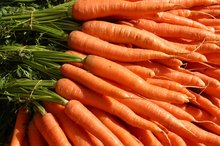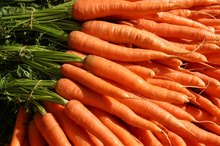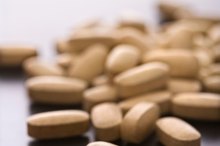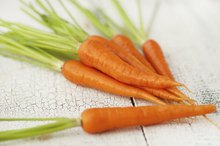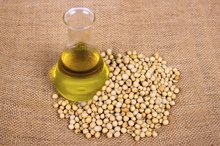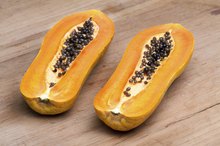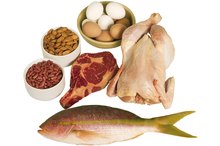Beta-Carotene While Pregnant
Beta-carotene is a precursor to vitamin A, which means that your body is able to use it to synthesize retinol if your liver has storage space for it. If your body contains enough vitamin A as retinol, beta-carotene is not converted. Women require more vitamin A during pregnancy and much more while lactating, but supplementing with retinol can be toxic in large doses. Beta-carotene provides antioxidant benefits and is safe to consume while pregnant because it is nontoxic. Consult with your doctor about adequate amounts of vitamins while pregnant.
Beta-Carotene
Beta-carotene is an orange-red pigment commonly found in fruits and vegetables, most notably carrots. It is the most common of a class of compounds called carotenoids found in plants. Beta-carotene displays strong antioxidant properties and is a precursor or inactive form of retinol, which is commonly called vitamin A. Vitamin A is essential in your body for healthy eyesight, especially night vision, and the maintenance and repair of mucous membranes.
Conversion to Retinol
Beta Carotene Conversion to Retinol
Learn More
Beta-carotene in your diet can be converted to vitamin A in your body, but the conversion is not perfect. In comparison with dietary retinol, you need at least six times as much dietary beta-carotene to produce the same amount of vitamin A. However, according to the Linus Pauling Institute, the vitamin A activity of beta-carotene from supplements is much higher than that of beta-carotene from foods. As a result, it takes only 2 mcg of supplemental beta-carotene to provide 1 mcg of vitamin A in your body.
Recommendations While Pregnant
According to the National Institutes of Health, pregnant girls up to age 18 require 750 mcg of vitamin A daily, whereas pregnant women 19 years and older need 770 mcg. Lactating women need considerably more, about 1,300 mcg daily. As a result, you should multiply those numbers by six if you want to derive your vitamin A from dietary beta-carotene sources, or by two if you take beta-carotene supplements.
Safety of Beta-Carotene
Is Too Much Beta Carotene Bad for You?
Learn More
Supplementing with retinol directly or consuming a high proportion of foods rich in vitamin A, such as liver, can lead to hypervitaminosis A and toxicity. The adverse effects of hypervitaminosis A can include liver dysfunction, neurological disorders, reduced bone mineral density and birth defects. Beta-carotene generally is considered safe during pregnancy because it is not associated with specific adverse health effects. Its conversion to vitamin A decreases when your body stores are full, so excess beta-carotene cannot become toxic. However, taking too much beta-carotene can cause carotenosis, a benign condition that results in a temporary yellowing of your skin.
Related Articles
References
- Linus Pauling Institute: Oregon State University: Carotenoids
- National Institutes of Health: Office of Dietary Supplements: Vitamin A and Carotenoids Fact Sheet
- Advanced Nutrition and Human Metabolism; Sareen Gropper et al.
Writer Bio
Sirah Dubois is currently a PhD student in food science after having completed her master's degree in nutrition at the University of Alberta. She has worked in private practice as a dietitian in Edmonton, Canada and her nutrition-related articles have appeared in The Edmonton Journal newspaper.
